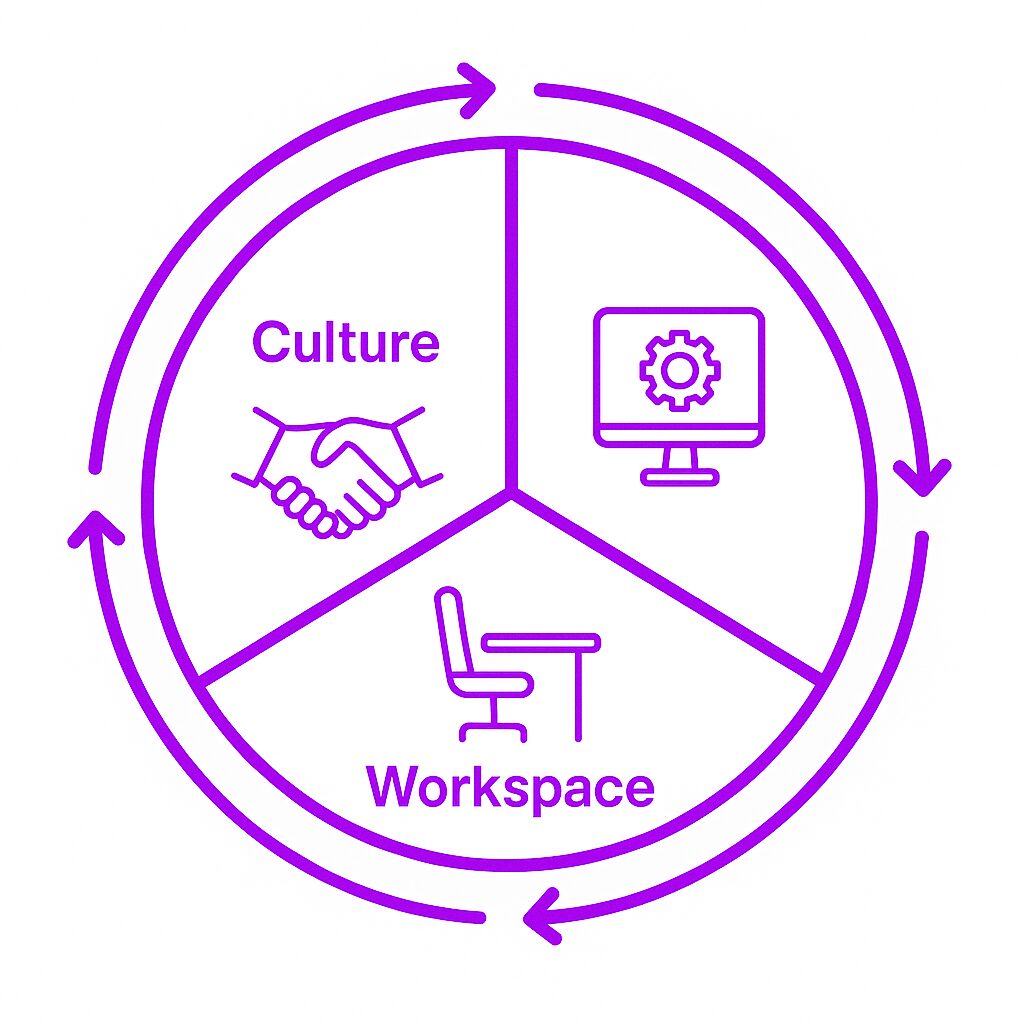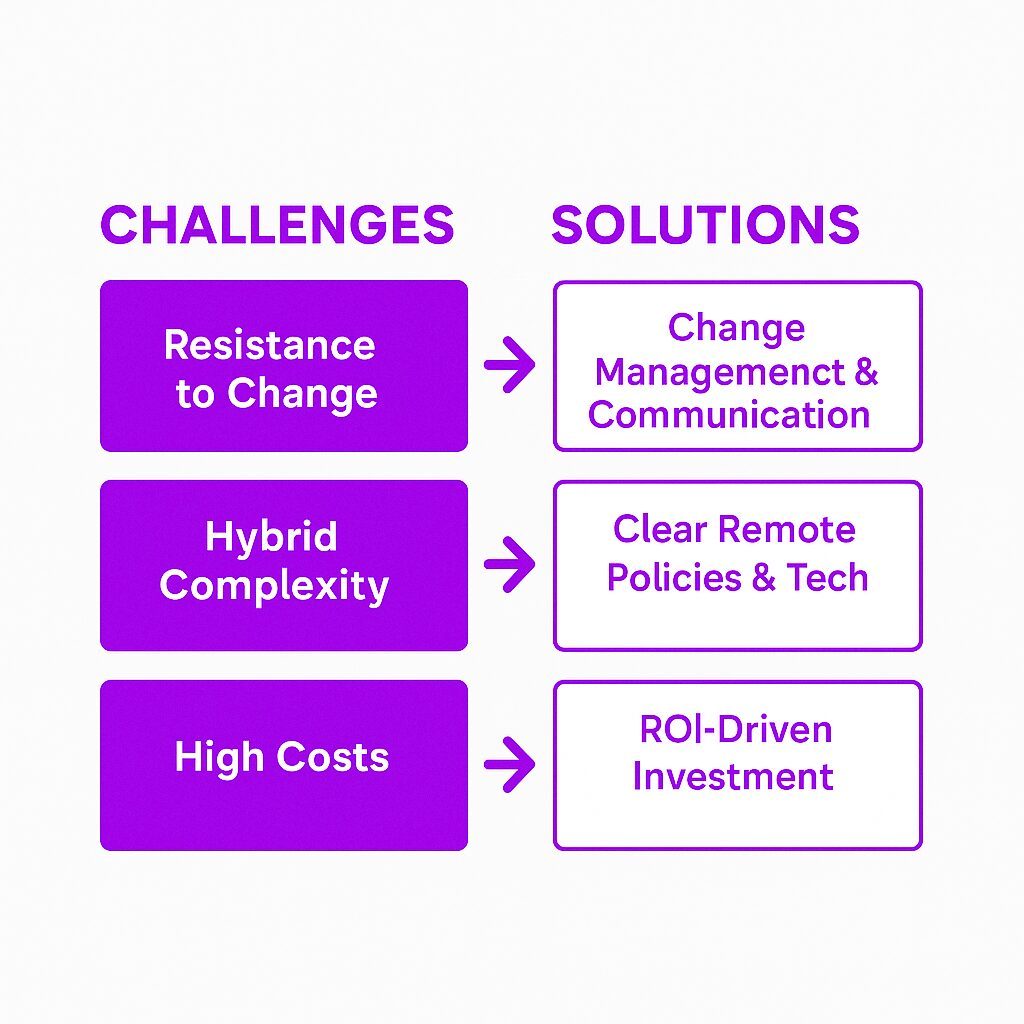What Is Employee Experience Management?
Employee experience management (EXM) is the process of shaping the way employees interact with their work environment, from their first day to their last. Employee experience initiatives are aimed at enhancing employee satisfaction and engagement through various strategies and practices. It focuses on every touchpoint in the employee journey—hiring, onboarding, daily operations, career growth, and even exit experiences. Organizations that invest in EXM aim to create a work culture that supports productivity, satisfaction, and retention.
Understanding Employee Experience vs. Employee Experience Management
Employee experience (EX) refers to how employees perceive their interactions within a company. It covers everything from workplace culture to digital tools and leadership effectiveness. Employee experience management (EXM), on the other hand, is the structured approach to improving those experiences. It involves collecting feedback through employee experience surveys, analyzing data, and making changes that improve engagement and performance.
A company can have a good or bad employee experience. EXM ensures that experiences are intentional rather than accidental.
Key Components of Employee Experience Management
Culture
A company’s culture defines how employees feel about their workplace. A culture that values trust, respect, and recognition leads to positive experiences. Toxic work environments, poor leadership, and lack of transparency damage engagement.
Physical Work Environment
Employees need comfortable and functional spaces to do their best work. Office layout, ergonomics, meeting spaces, and break areas impact productivity. Remote work adds another layer—ensuring home offices are equipped with the right tools is now part of EXM.
Technology
The right digital tools make work easier. Clunky, outdated systems frustrate employees and slow productivity. Seamless communication platforms, reliable software, and automation improve the employee experience.
Why Companies Focus on Employee Experience Management
Employee experience influences retention, engagement, and overall company performance. Enhancing employee experience is linked to improved productivity, retention, and overall success, which are critical business outcomes. A strong EXM strategy leads to:
-
Higher job satisfaction
-
Lower turnover
-
Increased productivity
-
Better customer service
Companies that fail to manage EXM risk losing employees to competitors with better work environments.
Benefits of Employee Experience Management
Higher Employee Engagement
Engaged employees are motivated, proactive, and committed. An employee experience manager plays a crucial role in understanding employee needs and developing strategies to enhance engagement. They contribute ideas, support team goals, and take ownership of their work.
Reduced Turnover
When employees feel valued, they stay longer. A positive experience enhances employee retention, lowers recruitment costs, and ensures institutional knowledge stays within the company.
Stronger Employer Brand
A company with a good reputation attracts top talent. People want to work for organizations that treat employees well.
Increased Productivity
Employees who have access to the right tools and a supportive culture work more effectively. Performance management plays a crucial role in regular performance reviews and feedback mechanisms, ensuring continuous improvement and engagement. EXM removes obstacles that slow teams down.
Improved Collaboration
A well-managed employee experience fosters teamwork. Whether in-office or remote, employees need communication tools and company-wide alignment to work together successfully.
Challenges in Employee Experience Management
Resistance to Change
New workplace strategies often face pushback. Employees and leaders may be skeptical about EXM initiatives, especially if past efforts have failed.
Hybrid and Remote Work Complexity
Managing employee experience is easier when everyone is in the same space. Remote and hybrid work models add complexity, requiring new approaches to culture, communication, and engagement.
High Costs
Investing in EXM—through technology, training, and cultural initiatives—can be expensive. Companies must balance costs with long-term benefits.
Measuring Success
EXM is not easy to quantify. Employee experience strategies involve collaborative efforts and data-driven insights to optimize the overall employee experience. Engagement surveys and performance metrics provide insights, but experience is subjective. Organizations must define clear KPIs.
Measuring Employee Experience Management
Employee Engagement Surveys
Regular employee experience surveys help companies gauge satisfaction and identify pain points. Anonymous responses encourage honest feedback.
Performance Metrics
Tracking absenteeism, retention rates, and productivity levels helps measure EXM effectiveness.
Real-Time Employee Feedback
Digital platforms allow employees to provide ongoing feedback, rather than waiting for annual reviews.
Employee Experience Strategy to Improve Employee Experience Management
Define Clear Goals
Companies need a structured approach to EXM, incorporating effective employee experience strategies. What are they trying to improve—engagement, retention, collaboration? Clear objectives guide efforts.
Foster Open Communication
Employees should feel heard. Open-door policies, anonymous feedback tools, and regular check-ins strengthen trust.
Invest in the Right Technology
Slow, outdated systems frustrate employees. Upgrading to user-friendly, integrated software improves daily experiences.
Support Work-Life Balance
Flexible work schedules, wellness programs, and realistic workloads prevent burnout. Employees who feel balanced perform better.
Train Leadership
Managers play a critical role in EXM. Employee experience managers, with essential skills such as change management, communication, empathy, and analytical abilities, are vital for fostering a positive work environment and addressing employee needs. Leadership training ensures managers understand how to support and engage their teams.
Recognize and Reward Employees
Employees need to feel valued. Recognition programs, bonuses, and even simple acknowledgments build motivation.
Related Concepts
Employee Engagement
Engagement is the emotional commitment employees have toward their work. Investing in ongoing training and development opportunities, known as employee development, enhances employee satisfaction and engagement. EXM plays a key role in driving engagement.
Digital Workplace
The tools and platforms employees use daily impact their experience. A well-managed digital workplace ensures smooth collaboration and productivity.
Workplace Culture
A company’s culture, encompassing its values, norms, and behaviors, defines the employee experience. Strong cultures create better experiences.
Employer Branding
Companies known for strong EXM attract top talent. Employer brand influences job seekers’ perceptions of a workplace.
Real-World Examples of Employee Experience Management
Tech Industry
Google focuses on employee experience through flexible work arrangements, career growth opportunities, and advanced workplace technology. An employee experience platform supports businesses in creating positive employee experiences that not only boost morale but also enhance overall business performance and resilience in times of change.
Retail and Customer Service
Companies like Starbucks invest in employee experience by offering competitive benefits, career development, and inclusive workplace policies.
Remote-First Organizations
Fully remote companies like Automattic (WordPress) build strong employee experiences through trust-based management and flexible work models.
Healthcare
Hospitals improving EXM see higher job satisfaction among nurses and doctors, leading to better patient outcomes.
Employee experience management is not just a trend. Companies that prioritize EXM create better workplaces, retain employees longer, and drive higher performance.







